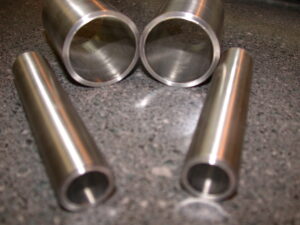S-Bond® active solder enables the joining of sapphire to metals and provides an alternative to other sealing processes. S-Bond joining of sapphire/metal seals is proving to be a more robust and reworkable joining process while being simpler than many of the existing sapphire widow sealing processes, as this article presents.
Sapphire bonding for window joining normally is done by either active brazing at elevated temperatures in high vacuum or by soldering and or brazing after metallization. Active brazing is limited by the need to match CTE between the metal and the sapphire since the joining temperatures occur above 800°C. Conventional brazing or soldering (non-active) is done after a multi-step pre-metallization process on the sapphire. Two pre-metallization steps are offered commercially. One is physical vapor deposition of a thin Ti layer then a Cr layer followed by Ni-electroplate. The other commercial pre-metallization technique is a thermally activated diffusion / chemical conversion process in wet H2 called the Mo-Mn process where Mo, MoO3, Mn and MnO2 react to form an oxide/metal composite which binds to the sapphire surface. This reacted glass-metal layer is then nickel plated to form a brazeable or solderable layer.
S-Bond® sapphire window sealing has emerged as a simpler soldering process with only two-steps. S-Bond joining centers around using “active” solder alloys with titanium and cerium added to Sn-Ag, Sn-In-Ag, and Sn-Bi base alloys. These active solders are able to be reacted directly with sapphire surfaces prior to bonding.
The joints produced are:
- Hermetic, passing < 10-9 atm-cc/ sec
- Strong (> 5,000 psi shear)
- Ductile, based on using Sn-Ag or Sn-In base alloys
The joining process starts with an S-Bond metallization process which is thermally activated using a proprietary process to prepare the sapphire surfaces to develop a chemical bond to the sapphire surface through reactions of the active elements in S-Bond alloy and sapphire (Al2O3 single crystal). This process starts with an elevated temperature treatment in a protective atmosphere furnace with S-Bond alloy placed on the sapphire surfaces to be joined. At the elevated temperatures, the active elements in S-Bond react with the sapphire to form a chemical bond. This chemical bond and the S-Bond layer in a subsequent joining step provides a much higher level of joint strength and creates high performance ceramic-metal joints.
Figure 1 are images of a sapphire window after pre-metallization steps on the edge of a sapphire window. Figures 2 shows the metallographic cross section of the sapphire where the S-Bond layer is reacted and adhered to the sapphire surface. The S-Bond layer has been reacted at elevated temperatures in a protective atmosphere to preserve the active elements in the S-Bond. Upon cooling and removal from the furnace, the part looks like the top image in Figure 1. The sapphire window is reheated ant the scaly excess layer is removed on the sapphire window edge to leave a smooth fresh, solderable layer as seen in the bottom image in Figure 1. This is done before assembling the window into the S-Bond tinned metal frame, tube or other type of enclosure.


To prepare the metal seal area for sapphire window assembly and bonding, the metal frame, tube or enclosure is heated and a layer of S-Bond alloy is melted and rubbed, brushed or otherwise mechanically activated to form and a thin layer of the S-Bond wetted and adhered to the metal sealing surfaces.
After both sealing surfaces are S-Bond “pre-tinned”, they are re-heated and fresh thicker layer of melted S-Bond is added to the metal joint side faying surface as the pre-tinned and heated window is placed into the sealing area and oscillated or rotated to slide the two S-Bond solder surfaces past one another to disrupt the thin oxide skin that forms on the S-Bond when heated in air. After the window and metal enclosure is oscillated it is positioned, and as needed extra solder is fed into any gaps in the seal to complete the joint before it is cooled to solidify the solder.
After cooling, the S-Bond joint can be machined or cut to remove excess solder and finish the joint to meet specifications. Note that S-Bond joining does not use chemical fluxes that must be cleaned up or could etch metallic components, leaving cosmetic defects.
S-Bond alloys produce reliable joints with all metals…including steel, stainless steels, titanium, nickel alloys, copper and aluminum alloys. The bonding is accomplished…
- Directly without the use flux.
- Without pre-plating steps, eliminating multiple step coating processes.
- At temperatures below 400ºC, preventing distortion and softening of metals and preventing sapphire fracture.
Examples of S-Bond Joined Sapphire Window Components


S-Bond joint shear strengths, using the elevated temperature S-Bond metallization procedure exceed 7,000 psi and are resistant to thermal cycling from -50 – 150ºC.
In summary, S-Bond® joining:
- Has fewer process steps than other sapphire joining procedures.
- Eliminates multiple- step metallization.
- Lowers joining temperatures compared to conventional active brazing.
- Permits larger and more complex assemblies to be fabricated without sapphire cracking.
- Increases process yields related to joint failures from poor metallization layers.
- Lowers joining costs with reduced steps
- Eliminates clean-up of flux residue
- Produces a reworkable joint that can be taken apart and reliably joined again
S-Bond Technologies has extensive experience in making sapphire window-metal seals with a robust high yield process. Please Contact Us so we can see how S-Bond can meet your sapphire window / metal sealing requirements.

One Response
Hello Stephen.
Thank you for reviewing our blog and expressing interest. Please email more specific information to info@s-bond.com.